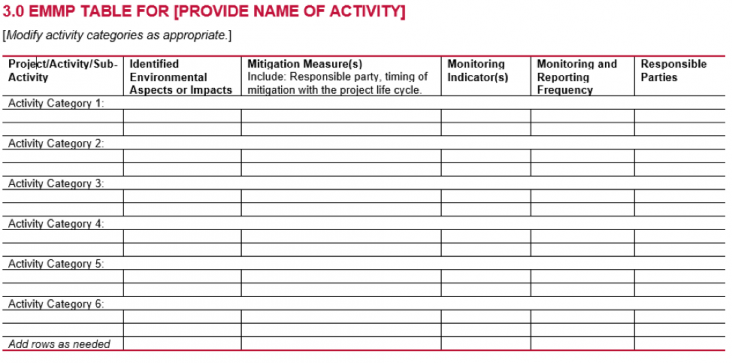- Environmental Procedures
- Environmental Compliance Officers
- Environmental Compliance Database (ECD)
- Safeguarding the Environment Over the Program Cycle
- 22 CFR 216: USAID's EIA Process
- Environmental Documentation: Types & Templates
- Mitigation, Monitoring & Reporting
- Environmental Compliance and Procurement
- Mission Processes; Roles and Responsibilities
- Environmental Procedures & Climate Risk Management
- Special Compliance Topics
- Principles of EIA
- Social Impact Assessment Principles
- Sectoral Environmental and Social Best Practices
- Biodiversity and Tropical Forest Analyses
- Training: Courses and Calendar
- Laws, Regulations and Policies
- Foreign Language Resources
- USAID Bureaus
- Safeguarding the Environment: Mission Support
- Europe & Eurasia
- Global Health
Speeches Shim
Mitigation, Monitoring and Reporting are essential elements of environmental compliance during implementation of USAID-funded activities.
Mitigation is the implementation of measures designed to eliminate, reduce, or offset the undesirable effects of a proposed action on the environment. Most Initial Environmental Examinations (IEEs) and all Environmental Assessments (EAs) establish conditions (mitigation requirements) that must be complied with during activity design and implementation. (See 22 CFR 216: USAID’s EIA Process for an introduction to IEEs and EAs.)
Monitoring is an essential complement to mitigation. It is BOTH (1) determining whether mitigation is being implemented as required; and (2) determining whether mitigation is sufficient and effective.
EMMPs. Experience shows that systematic implementation of mitigation measures – and thus compliance with IEE and EA requirements – requires an Environmental Mitigation and Monitoring Plan (EMMP). For this reason, EMMPs are required almost universally by IEEs and EAs across USAID bureaus. EMMPs are also called Environmental Management Plans (EMPs), Mitigation and Monitoring Plans (M&M Plans), and other similar names.
An EMMP:
- TRANSLATES IEE or EA conditions into specific mitigation measures (if the conditions are general)
- SETS OUT indicators/criteria for monitoring the implementation and effectiveness of mitigation measures
- ESTABLISHES timing and responsible parties
The activities analyzed within an EMMP correspond directly to the activities described within the project’s corresponding IEE or EA. An EMMP may be extended to include budgeting information (costing of mitigation and monitoring measures) and a log for recording monitoring results. EMMPs are usually in table form. Most new IEEs require use of the Agency’s EMMP template:

(Download the EMMP template via the Environmental Documentation: Types and Templates page)
Reporting
ADS 204.3.4.b requires that AORs and CORs actively monitor the compliance of projects and activities under their purview with the mitigation requirements/conditions set out in IEEs and EAs. (ADS 204 refers to these requirements as the “environmental components designed for the activity resulting from the 22 CFR 216 process”). For AORs or CORs to fulfill these responsibilities, implementing partners report on environmental compliance as one portion of routine activity implementation performance reporting.
IEEs generally require the use of the Environmental Mitigation and Monitoring Report (EMMR) for this purpose. EMMRs are typically submitted annually, but the frequency will be stipulated in the IEE. The IEE may also specify other environmental compliance reporting requirements.
The EMMR template describes the purpose and scope of the EMMR.
Mitigation, Monitoring, EMMP and Reporting Resources
The following resources provide additional information on each of these topics
- EMMPs: Distance learning module on EMMP Development
- EMMRs: Factsheet providing an overview of EMMRs and best practices for developing an effective EMMR.
- Mitigation and Monitoring Theory and Principles: Topic Briefing: Intro to EIA
- Sector-specific mitigation and monitoring guidance: consult the sectoral environmental guidelines.
- EMMP and EMMR templates: Environmental Documentation: Types and Templates page
- Budgeting for Mitigation and Monitoring: Aligning Budgets for Implementing Environmental Compliance Safeguards in USAID Development Food Assistance Programs Toolkit

Comment
Make a general inquiry or suggest an improvement.